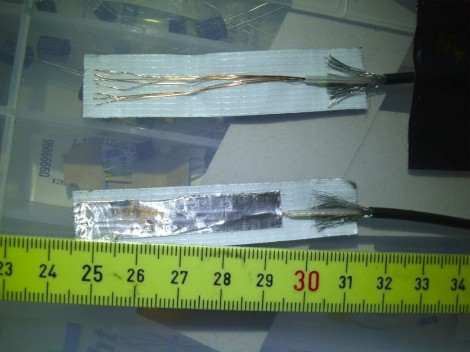[Ericdsc] is looking to capture the electrical impulses of his muscles by using an EMG. He went through several prototypes to find the right recipe for sensors to pick up the electrical signal through his skin. Above you can see the version that worked best. Each sensor is made starting with a piece of duct tape and laying out a patch of stripped wire on it. A 5cmx1xm piece of aluminum foil then covers this, and second smaller piece of foil covers the cable’s shielding (not pictured here). This will stick to your skin to hold the sensor in place after applying a dab of sugar syrup to help make a good electrical connection.
In this case, an audio recorder is taking the measurements. [Ericdsc] had been having trouble sleeping and wanted to find out if he’s restless in bed. The audio recorder can log hours of data from the sensors which he can later analyze on the computer. Of course, it wouldn’t be hard to build your own amplifier circuit and process the signals in real-time. Maybe you want to convert that mind-controlled Pong game over to use abdominal control. You’ll have a six-pack in no time.















Chuck Norris doesn’t need amplifiers on his muscles.
this could also have uses to detect your level of sleep for a propmt system to help a person get into lucid dreaming, cause, if your not gonna get any rest while sleeping all night, you might as well be doing whatever you want.
Having issues with sleep myself, that is unfortunately not how it works. If I could harness all these hours being awake into something productive I would be rich…
You have stereo input righ? What about using the second channel to eliminate the noise and interferrences? ECG uses at least three electrodes too. One is ground, the second is used to measure and signal from third is just subtracted from the second electrode to eliminate any unwanted interferring signals.
You can even see it on the image:
http://i47.tinypic.com/5vu0dv.png
there is already some kind of noise in other chanel (probably 50 or 60Hz Mains AC hum). If you subtract this from measured signal you will get much cleaner output. If you also engage the third electrode sticked to the right place of body, you will get even more clean signal…
BTW you can use sonogel used for sonography/echo (which can be obtained for cheap in pharmacy store) instead of sugar syrup. Piece of cotton or sponge soaked in salt water will also do…
Is there a way to do the noise cancellation on the fly using basic components? I’d imagine doing it in post-processing software would be more accurate, but for the sake of experimentation I think this could be great.
I guess that some general op-amp IC can subtract two signals while maintaining reasonable quality… but it can’t cancel any noise induced between itself and sampling hardware used to record it, so you have to shield it properly or somehow minimize interferences that can happen there…
Generally one will attempt to obtain the common-mode signal between the two electrodes, invert it, and feed it back into the body in order to cancel any interference that occurs on both electrodes. This feedback is often used in the third (nonsensing) electrode of ECGs aside from decreasing the common-mode voltage.
Aside: You aren’t required to use at least three electrodes for an ECG. You can get away with two or even one if you use a few tricks.
It has be already done:
http://www.swharden.com/blog/2009-08-14-diy-ecg-machine-on-the-cheap/
http://hackaday.com/2009/08/22/collect-and-analyze-ecg-data/
Title should have read, “OMG WTF DIY EMG uses an audio recorder”…
LOL :)
Maybe I’m missing something here, but wouldn’t it just be simpler/better to buy a bag of electrodes?
http://www.amazon.com/Red-Dot-Multi-Purpose-Monitoring-Electrode/dp/B002C2M90I
Why wouldn’t these work better?
that said, I think that it’s really cool that OP iso using the A/D converters inherent to audio recorders instead of a specialized component.
Nice to see low-tech body hacks. But I doubt that I could sleep easy with wires taped to my skin. Wouldn’t a motion-sensor (like one on your phone) do the job as good?
I think that guys from sleep lab in brmlab (Prague hackerspace) were using PIR motion detector for sleep monitoring purposes… (well… alongside with EEG and few more gadgets :-)
http://brmlab.cz/project/brain_hacking
That’s how sleep studies are done dude. A crap-ton of wires and they also ask you to lay flat on your back which for me just doesn’t work. They are not very user-friendly tests.
comparing with EMG patterns your graph reads a neuropathy case? I’m not a Dr,